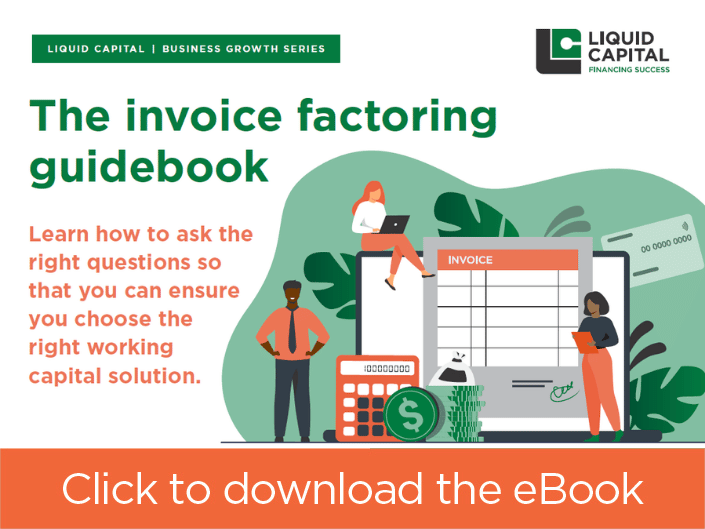You don’t need to lose your groove when you hit a wrong note with your financing. Overcome cash flow challenges and keep the beat going with invoice factoring.

For many business owners, growing a company can often feel like you’re improvising as part of a jazz ensemble – you and your team are trying to create beautiful music on the fly. And if you miss a note and hit a cash flow challenge, it can throw you off the beat of success.
However, just as any musician (and savvy business owner) knows, it’s not the notes that you’ve already played that matter; it’s the notes you play next that do. And often your inspiration for the next note comes from your fellow musicians.
So if you or your client need some inspiration for overcoming a wrong note, keep reading to learn how these entrepreneurs created their magnum opus, seized growth opportunities and created beautiful music (even after playing a wrong note or two).
Overcome long payment terms
Ray Bowman, Owner and President of Rayzor Edge Tree Service had plans to take his company, which provides professional, environmentally conscious tree services for commercial and residential properties in southern Ontario, to new heights. But his goals for growth initially outpaced his working capital.
As a small firm, he was constrained by cash flow, as his need to pay subcontractors quickly was met head-to-head with invoice payment times of 30 to 120 days from commercial customers, limiting the number of jobs he could accept.
“Before working with Liquid Capital, we just didn’t have the cash flow to support our growth. We were confined to doing basically a job a month or so. Now with Liquid Capital behind us, we’ve freed up our cash flow to continue to grow — and there’s no ceiling on it.”
– Ray Bowman, Rayzor’s Edge
For Bowman, tapping into the power of his accounts receivable through invoice factoring was the solution. The extra working capital allowed him to double his sales, maintain positive relationships with valuable subcontractors, while also benefitting from the business support and advice of his Liquid Capital principal.
Overcome offering early payment discounts
Similarly, opportunities for further growth were abundant for thriving audiovisual company Best Broadcast — the business was booming after a successful launch set the stage for new business opportunities to work with major companies.
At the same time, Best Broadcast was facing a cash flow crunch that was limiting the company’s ability to sustain its upward momentum. Customers were taking 45, 60 or 90 days to pay their invoices – often, hundreds of thousands of dollars were tied up in outstanding accounts receivables. While the company initially tried to remedy the situation by offering clients a five percent discount if they paid their bill in full within 15 days, the heavy discounts started to eat into the bottom line.
After taking the time to understand and evaluate the invoice factoring process, Dave Kip, CEO of Best Broadcast decided that the best way to access more reliable working capital was to put his accounts receivables to work with the help of Liquid Capital.
“Liquid Capital allows me to operate without stress. If a company is offering early payment discounts, factoring is a cheaper option to gain access to money.”
– David Kip, Best Broadcast
With a reliable alternative financing solution in place, Best Broadcast immediately had access to the funds it needed, increasing cash flow and alleviating Kip’s worries around day-to-day operational costs so he could focus on his business strategy and successfully scale his company.
Overcome traditional funding solutions

Having enough staff and enough materials to fill orders are the two most important factors for running a successful manufacturing business. They also require sufficient working capital – you need to pay your employees regularly, and you need to purchase materials to fill orders.
For Summit Retail Solutions, invoice factoring was exactly what they needed to access regular cash to cover these two major operating expenses. They had purchase orders worth hundreds of thousands of dollars in the pipeline and business was booming for the two-year-old custom manufacturer of premium store display fixtures.
However, without an established credit history, the company did not qualify for traditional bank financing, and its small business line of credit wasn’t enough to help them continue growing. As their cash flow started to dry up, they struggled to fill large orders, while supply chain and payroll issues began to threaten operations.
After researching several factoring companies, Summit Retail chose Liquid Capital’s invoice factoring solution for its creativity in meeting the company’s specific needs and for its exceptional service and support.
“I honestly believe that we would not have had this success without Liquid Capital’s ability to cut through the red tape and factor our receivables. I would strongly recommend this course for other companies that require working capital to grow.”
– Ted Hope, Summit Retail Solutions
With the influx in working capital, Summit was able to draft larger contracts and drive more business. Almost immediately, they began to enjoy higher sales growth, and in just 18-months of working with Liquid Capital, sales more than doubled, going from $1.4 million to over $4 million. Now firmly established – and with the track record to prove it – Summit was soon able to secure traditional bank financing to fund its continued growth.
Overcome cash conversion cycles that can’t support growth

When the glove fits, it fits! And for many businesses, including Dig It Apparel Inc., invoice factoring fit their business needs just right.
When the co-founders came up with the idea for Dig It Handwear® —a line of utility/gardening gloves specifically targeted to women because they could protect hands and manicured nails—they knew it was a good one. What they weren’t prepared for was how good—and how in-demand—their product would be after an appearance on a Canadian TV Show, Dragon’s Den.
“We fell into the gap. A small business loan is usually about $50,000, which we qualified for, but we needed between $200,000 and $250,000—and weren’t even sure specifically how much. The bank needed more solid information to bump us up to a commercial loan, and we didn’t have it. So we were not able to get the loan secured in time for manufacturing. We needed to look at other options.”
– Claudia Harvey, Dig It Apparel
In need of financing—and fast—Dig It started exploring the options. They started talking to other banks, but didn’t yet have the relationships or track record needed. Next, they considered selling a portion of their company—fortunately, a trusted person in their business network introduced them to Liquid Capital before that became necessary.
Working with Liquid Capital enabled Dig It to expand, and offer banks the solid projections necessary to obtain traditional financing.
Overcome financial instability caused by seasonal demands
For any type of business that relies on seasonal buying cycles, finding sufficient cash flow to keep you going through the slow months can be challenging.
For Ridgeline Manufacturing, this was the problem they faced specializing in summer recreational equipment. The winter months brought lean times, and owners Nick and Julie Newman knew that they couldn’t lay off their workforce and close production for half the year. However they also didn’t qualify for traditional funding options.
Though they had previously tried factoring with other providers, but were turned off by the experience. But when they were introduced to their Liquid Capital Principal, they knew working with Liquid Capital would be different.
“With a lot of other companies, you go through tons of different people—even just to get an approval. After you’re approved, you still don’t have a dedicated contact. At Liquid Capital, I know who I’m dealing with—and I know he’s looking out for my best interests, and trying to save us money whenever possible.” – Nick Newman, Co-Owner, Ridgeline Manufacturing
With Liquid Capital there were no minimums or penalties for inconsistently factoring their invoices, and Nick liked that he wouldn’t be charged interest on money already collected. With the flexibility Liquid Capital gave them, Ridgeline was able to not only coast through the winter months, but also continue growing during the busy times.
Overcome unforeseen events
When traditional funding options just don’t cut it, invoice factoring can help businesses that find themselves in hard-to-finance situations. For Silani Cheese, they had a quality product and demand was high, however after a series of financial obstacles, they needed an influx of working capital.
Naturally the company turned to the banking facility it had in place for help. Unfortunately, certain margin criteria in the banking arrangement unexpectedly changed resulting in a reduced credit facility, forcing it to negotiate an insolvency/restructuring proposal with its creditors.
During the restructuring process, the company had repaid its bank debt using personal funds as well as financing from Farm Credit Canada, but in order to fully exit the proposal, it needed a broader financing solution—one that factoring could readily deliver.
“The other companies we dealt with just weren’t cutting it. Their financing approach made us nervous, and they made promises they couldn’t keep. When Liquid Capital came in and took over the deal, everything changed. We were three weeks into problematic negotiations with the other company—with an irreversible deadline looming—and Liquid Capital team jumped in, put everything together and closed the deal two days ahead of schedule.”
– Joe Lanzino, Silani Sweet Cheese Ltd.
Despite arriving rather late in the process, Liquid Capital impressed immediately with their face-to-face approach, deadline-driven commitment and upfront clarification of what was possible in terms of timing.
In the end, Liquid Capital negotiated the deal, completed due diligence and funded Silani on the timeline it needed—all in less than three weeks—enabling Silani to exit the insolvency proposal and repay the Farm Credit loan as well.
Different industries, same cash flow challenges

These businesses turned their accounts receivables from a daily headache into a tool to help them drive positive cash flow and ensure their companies continue to thrive.
When you have the right funding partner, you can avoid those ‘wrong notes’ in your business orchestra.
If payment delays from your credit-worthy customers are resulting in missed growth opportunities for you or your clients, Liquid Capital can help you keep your business beat going.
“You want your business to be more than it is today. You’re facing the opportunities in front of you but you’re lacking in the cash or the capital… Let us help you by showing you a light at the end of the tunnel — and the best way to do that is to accelerate that cash cycle by replacing your near-current assets with cash.” – Liquid Capital Principal
Ready to learn more about invoice factoring? Contact your Liquid Capital Principal – we’ll take the time to learn about your goals and challenges and will deliver accelerated funding solutions that hit the right note.

















































